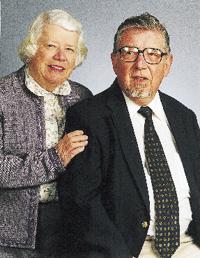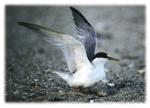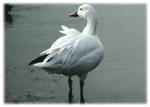A Silence in September
by Richard G. Johnstone Jr., Editor
L. John Trott Jr.,
Naturalist and Teacher
1927-2000
 In the increasingly
urban Virginia of the early 21st century, he taught our 300,000-plus readers about wild
things, such as the virgin forest that blanketed the eastern U.S. when Europeans first set
foot here 400 years ago, and which is now confined to a few scattered fragments. And, of
course, most of all he taught us — with passion and purpose, filled with lively
anecdotes and historical tidbits — about the birds that frequent the Old Dominion.
But like the birds he loved and captured on film and through words, his sweet song was all
too brief, being stilled by a heart attack on September 6. He leaves behind his devoted
wife of 39 years, Lenore or "Lee" as he called her affectionately in his
columns, plus legions of colleagues, friends and regular readers of this magazine.
In the increasingly
urban Virginia of the early 21st century, he taught our 300,000-plus readers about wild
things, such as the virgin forest that blanketed the eastern U.S. when Europeans first set
foot here 400 years ago, and which is now confined to a few scattered fragments. And, of
course, most of all he taught us — with passion and purpose, filled with lively
anecdotes and historical tidbits — about the birds that frequent the Old Dominion.
But like the birds he loved and captured on film and through words, his sweet song was all
too brief, being stilled by a heart attack on September 6. He leaves behind his devoted
wife of 39 years, Lenore or "Lee" as he called her affectionately in his
columns, plus legions of colleagues, friends and regular readers of this magazine.
 John Trott began
writing for us in early 1998, and his first column in the March/April issue that year was
titled, "The Cardinal: A Good Omen." That particular column focusing on
Virginia’s state bird was certainly a good omen for us, as the 27 columns he would
ultimately write for us —all featuring the superb photos that would become his
signature — became among the most popular features in Cooperative Living.
John Trott began
writing for us in early 1998, and his first column in the March/April issue that year was
titled, "The Cardinal: A Good Omen." That particular column focusing on
Virginia’s state bird was certainly a good omen for us, as the 27 columns he would
ultimately write for us —all featuring the superb photos that would become his
signature — became among the most popular features in Cooperative Living.
I’d like to say I knew John Trott well, since I feel that I did through the
friendly, conversational style of his writing, the exquisite beauty of his bird
photographs, and the occasional phone call I enjoyed with him. And just as cooks swap
recipes and fishermen swap lies, he and I would "swap" favorite books on nature.
I recommended Hal Borland’s This Hill, This Valley, and Henry Beston’s Northern
Farm.
He suggested Edwin Way Teale’s autobiographical A Naturalist Buys an Old Farm. In
it, Teale wrote poetically and in John Trott-like fashion about the flight of the woodcock
at dusk on March nights: "There is always something particularly moving about the
ecstasy of this dull-appearing brown and dumpy bird, this feeder on earthworms, this
boggy-ground dweller, as it mounts up and up into the sky and then plunges with its wild
gyrations back to earth again. It seems a spirit unfettered for a time, transcending its
ordinary days, attaining a superlative moment. There is something symbolic about its
flight." John Trott’s writing was much like that, deceptively simple,
"attaining a superlative moment" through his loving descriptions of birds and
his richly colorful photographs of them.
 Another of John
Trott’s favorite writers, Aldo Leopold, wrote the landmark conservation classic, A
Sand County Almanac, in 1949, and at the end of a long chapter on the natural history of
the U.S., Leopold wrote, "These things I ponder as the kettle sings, and the good oak
burns to red coals on white ashes. Those ashes, come spring, I will return to the orchard
at the foot of the sand hill. They will come back to me again, perhaps as red apples or
perhaps as a spirit of enterprise in some fat October squirrel who, for reasons unknown to
himself, is bent on planting acorns."
Another of John
Trott’s favorite writers, Aldo Leopold, wrote the landmark conservation classic, A
Sand County Almanac, in 1949, and at the end of a long chapter on the natural history of
the U.S., Leopold wrote, "These things I ponder as the kettle sings, and the good oak
burns to red coals on white ashes. Those ashes, come spring, I will return to the orchard
at the foot of the sand hill. They will come back to me again, perhaps as red apples or
perhaps as a spirit of enterprise in some fat October squirrel who, for reasons unknown to
himself, is bent on planting acorns."
John Trott spent over 40 of his 73 years as a teacher of botany and ornithology, in
both public and private schools. He also taught through his nature column in this
magazine, and through a separate column he wrote for several Virginia weekly newspapers
near his home in Rappahannock County’s Flint Hill.
Like the oak ashes described by Leopold, John Trott’s words and images will
continue to come back to me, and undoubtedly to thousands of his devoted readers.
We’ll remember John Trott as we watch and admire the juncos and sparrows and evening
grosbeaks and purple finches and chickadees and goldfinches and blue jays and woodpeckers
that he studied in the great classroom of the outdoors, and taught us about in the
"textbook" of a magazine column.